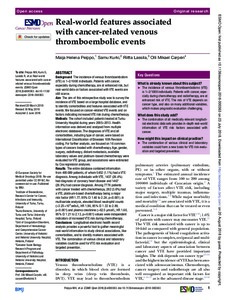Real-world features associated with cancer-related venous thromboembolic events
Samu Kurki; Maija Peippo; Olli Carpén; Riitta Lassila
https://urn.fi/URN:NBN:fi-fe2021042719276
Tiivistelmä
Background
The incidence of venous thromboembolism (VTE) is 1–2/1000 individuals.
Patients with cancer, especially during chemotherapy, are at enhanced
risk, but real-world data on factors associated with VTE events are
still scarce.
Aim
The aim of this retrospective study was to survey the incidence of VTE
based on a large hospital database, and to identify comorbidities and
features associated with VTE events. We focused on cancer-related VTE
events and on factors indicating increased VTE risk during chemotherapy.
Methods
The cohort included patients treated at Turku University Hospital
during years 2005–2013. Health information was derived and analysed from
multiple electronic databases. The diagnoses of VTE and all
comorbidities, including type of cancer, were based on International
Classification of Diseases 10th Revision coding. For further analysis,
we focused on 16 common types of cancers treated with chemotherapy. Age,
gender, surgery, radiotherapy, distant metastasis, available laboratory
values and platinum-based chemotherapy were evaluated for VTE group,
and associations were estimated by Cox regression analyses.
Results
The entire database contained information from 495 089 patients, of
whom 5452 (1.1%) had a VTE diagnosis. Among individuals with VTE, 1437
(26.4%) had diagnosis of coronary heart disease and 1467 (26.9%) had
cancer diagnosis. Among 7778 patients with cancer treated with
chemotherapy, 282 (3.6%) had a VTE, platinum-based chemotherapy being a
major risk factor (HR 1.77, 95% CI 1.40 to 2.24, p<0.001). In
multivariate analysis, elevated blood neutrophil counts (>3.25×109 cells/L,
HR 1.96, 95% CI 1.33 to 2.89, p<0.001) and plasma creatinine
(>62.5 μmol/L; HR 1.60, 95% CI 1.21 to 2.13, p=0.001) values were
independent indicators of increased VTE risk during chemotherapy.
Conclusions
Longitudinal electronic health record analysis provides a powerful tool
to gather meaningful real-world information to study clinical
associations, like comorbidities, and to identify markers associated
with VTE. The combination of various clinical and laboratory variables
could be used for VTE risk evaluation and targeted prevention.
Kokoelmat
- Rinnakkaistallenteet [19218]
